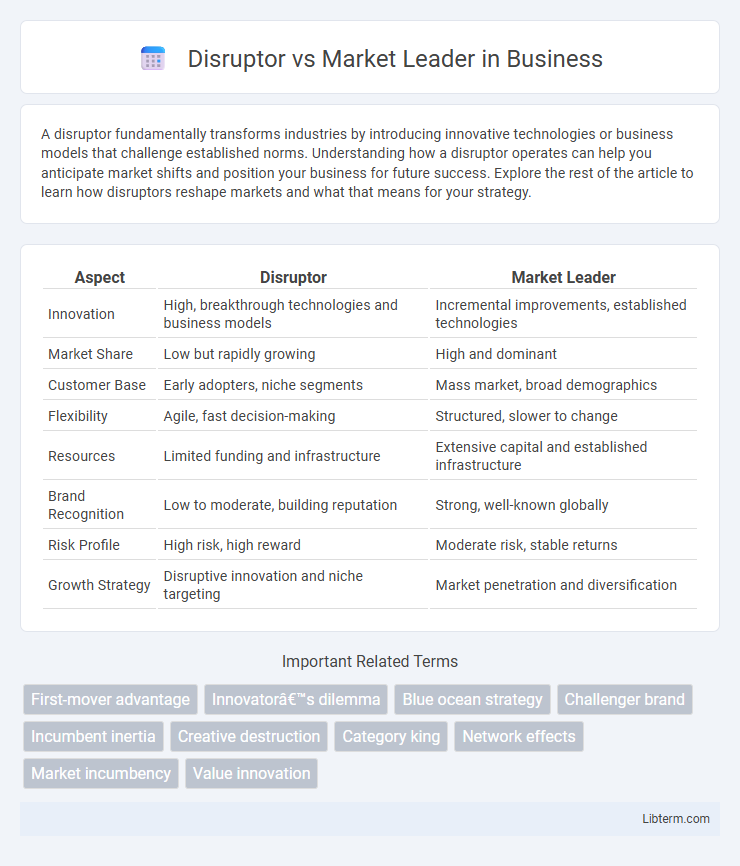A disruptor fundamentally transforms industries by introducing innovative technologies or business models that challenge established norms. Understanding how a disruptor operates can help you anticipate market shifts and position your business for future success. Explore the rest of the article to learn how disruptors reshape markets and what that means for your strategy.
Table of Comparison
| Aspect | Disruptor | Market Leader |
|---|---|---|
| Innovation | High, breakthrough technologies and business models | Incremental improvements, established technologies |
| Market Share | Low but rapidly growing | High and dominant |
| Customer Base | Early adopters, niche segments | Mass market, broad demographics |
| Flexibility | Agile, fast decision-making | Structured, slower to change |
| Resources | Limited funding and infrastructure | Extensive capital and established infrastructure |
| Brand Recognition | Low to moderate, building reputation | Strong, well-known globally |
| Risk Profile | High risk, high reward | Moderate risk, stable returns |
| Growth Strategy | Disruptive innovation and niche targeting | Market penetration and diversification |
Understanding Disruptors and Market Leaders
Disruptors innovate by challenging existing market norms, leveraging cutting-edge technology and agile business models to capture unmet customer needs. Market leaders maintain dominance through brand loyalty, extensive resources, and established distribution channels that enable scalability and trust. Understanding disruptors involves analyzing their ability to rapidly adapt and introduce value, while market leaders excel in sustaining long-term competitive advantages and operational efficiencies.
Defining Key Characteristics
Disruptors rapidly innovate by introducing groundbreaking technologies or business models that challenge established market norms, often prioritizing agility and customer-centric solutions. Market leaders maintain dominance through extensive resources, strong brand equity, and a broad, loyal customer base, leveraging scale to optimize efficiency and influence industry standards. Both entities shape market dynamics, with disruptors driving change and market leaders ensuring stability and maturity.
Evolution of Market Competition
Disruptors reshape industry dynamics by introducing innovative technologies and business models that challenge established norms, forcing market leaders to adapt or risk obsolescence. Market leaders leverage their resource advantages and brand recognition to defend market share while evolving strategies to counteract disruptive threats. This ongoing evolution intensifies market competition, driving continuous innovation and shifting consumer expectations.
Strategies of Disruptors
Disruptors deploy innovative strategies such as leveraging emerging technologies, prioritizing customer-centric models, and adopting agile business practices to challenge established market leaders. They often target underserved market segments with cost-effective solutions and rapid scalability, enabling swift market penetration. These approaches allow disruptors to redefine industry standards and capture significant market share from incumbent leaders.
Strengths of Market Leaders
Market leaders possess unparalleled brand recognition and extensive customer loyalty, driving consistent revenue streams and market stability. Their established distribution networks and significant economies of scale enable cost advantages and operational efficiency unattainable for disruptors. Access to vast resources facilitates continuous innovation and strategic acquisitions, reinforcing their dominant position in competitive landscapes.
Disruptor vs Market Leader: Innovation Approaches
Disruptors prioritize rapid, customer-centric innovation by leveraging agile methodologies, cutting-edge technologies, and unconventional business models to capture emerging market needs. Market leaders often rely on incremental improvements and established processes to sustain their competitive advantage, focusing on scalability and risk mitigation. The innovation approach of disruptors emphasizes speed and flexibility, while market leaders prioritize stability and efficiency in their product development cycles.
Impact on Industry Dynamics
Disruptors challenge market leaders by introducing innovative technologies and business models that redefine industry standards and customer expectations. Market leaders often respond by accelerating product development, optimizing operations, and revising strategic priorities to maintain competitive advantage. This dynamic interaction drives industry evolution, fostering increased competition, faster innovation cycles, and shifting market share distributions.
Customer Perception and Loyalty
Disruptors often attract customers by offering innovative solutions and personalized experiences that challenge traditional market leader models. Market leaders benefit from established brand trust and extensive customer loyalty programs that reinforce long-term commitments. Customer perception shifts as disruptors emphasize value and agility, while market leaders leverage reputation and reliability to maintain loyalty.
Case Studies: Notable Examples
Tesla's rise as a disruptor in the automotive industry showcases how innovation in electric vehicles and direct sales models challenged established market leader General Motors. Netflix disrupted the traditional media market by shifting from DVD rentals to a streaming-first strategy, outpacing Blockbuster's decline. Amazon's dominance in e-commerce displaced Walmart's retail leadership through advanced logistics and cloud computing services, illustrating key patterns in successful disruption.
Future Trends and Predictions
Disruptors are reshaping industries by leveraging advanced technologies like AI, blockchain, and sustainable innovation, positioning themselves to outpace traditional market leaders in agility and customer-centricity. Market leaders are increasingly investing in digital transformation and strategic partnerships to maintain dominance amid rising competition from nimble startups and evolving regulatory landscapes. Future trends indicate a continued shift towards decentralized ecosystems, personalized experiences, and green technologies, with disruptors expected to drive groundbreaking changes while market leaders must adapt rapidly to avoid obsolescence.
Disruptor Infographic

 libterm.com
libterm.com